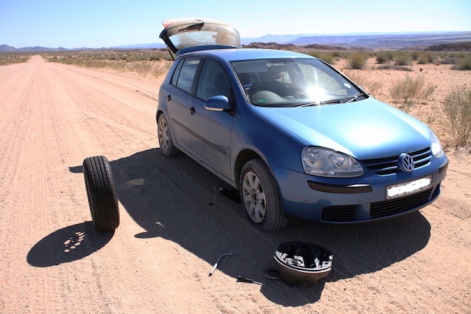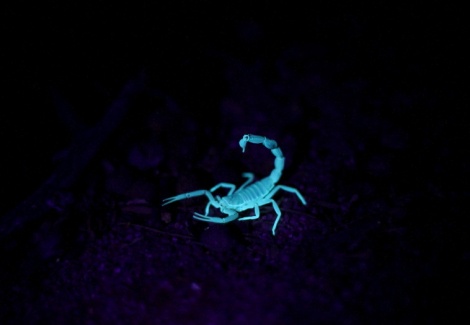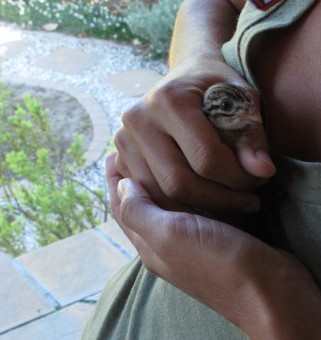Sooo we decided to take a trip to Namibia. Driving. In a little VW Golf. In defense of the car, it was unfair to drag it over such roads. In defense of me, a 4×4 was simply not in the budget, so as with most things in life, we improvised and rolled with what we had. Here is a bulleted blow-by-blow account of our whirlwind tour.
- Cape Town to Fish River Canyon in one day. This is 977km (607 miles). It is lovely for a few hours outside of Cape Town, then it gets dry. Then drier. Then it’s just dust everywhere. And a few sheep. (Saw my first actual black sheep!) And some odd-looking trees called quiver trees. And lots of rocks. Then no more trees at all. Just rocks. And finally nothing but tan-coloured dirt.
- A very slow and unwelcoming border post. But they did eventually let us through. (To their credit, they were much nicer and faster on the way out – though not sure if I should read into that or not.)
-

Arriving at the border between South Africa and Namibia
- One blowout on the empty dirt roads from Ai-Ais to Hobas camp. I also would like to add that we sadly took out more than a few birds on our travels. Unfortunately, it is virtually impossible to slam on brakes on loose sand. Birds that decide to sit in the middle of the sand/dirt road seem to be simply asking for a quick death via grill.
-

our sad little VW Golf loses a shoe on the rough roads in southern Namibia
- No restaurant on-site once we arrived at Fish River Canyon (and we’d packed nothing but some nonperishable goods), so food and drink options are limited to the small shop at the reception area, which had little more than tinned beef, bread, and milk.
- A beautiful sunset spent sitting – sundowners in hand, because though we couldn’t get food, we could get alcohol – at the edge of a massive and empty canyon, lulled by the shushing of a warm wind, the gentle cries from a pair of Verreaux’s Eagles somersaulting like acrobats through the air, and pretty much nothing else. There was not another human for miles.
- A night venturing out into the empty space behind our camp, startling a dazzle of zebra (no joke, that’s what a group of zebra is called), tracking down frogs, and practicing our star photography. Stumbled upon an old car that looked like it had been abandoned there a few decades ago. Briefly made me wonder if, given the roads we’d arrived on, and the fact that we still had a long way on more dirt roads to go to Sossusvlei, our car would be joining it in this desert graveyard.
- Waking up to a chorus of what sounded like a million different species of bird. Watching a lone baboon make his way through camp, checking every bin he passed in a search for tasty morsels. A morning spent lazing about, bird watching, followed by a full day in Fish River Canyon, walking in extreme temperatures amongst shale, some limestone and quartz, and not much else. The only mammals we saw, other than the baboon at camp, were a hare and a klipspringer. Even the birds and the reptiles were quiet. The afternoon was spent in the pool in a vain attempt to cool down. A minor disruption of gunfire as someone shot towards the troop of baboons coming down the hillside towards the camp. The baboons tucked tail and did a 180 out of there. Then silence.
- Evening braaing with a can of beans, a can of bully beef, and some potatoes. And a big slab of chocolate. Because I will always find a way to make sure chocolate is somehow involved in any activities.
- Twelve hours driving from Fish River Canyon to Sesriem Camp, after a rough road incident along the way that set us back many hours and possibly even more years of life, given the stress levels it induced. (Be forewarned – paved roads in Namibia aren’t actually paved in the sense of being sealed like tarmac, and locals have no qualms about running into the road – and into your car, though I’ve found this in South Africa as well.)
- Set up camp and scouted out the neighbours, which included about a thousand sociable weavers, a horned adder, a few dozen barking geckos, a Bibron’s thick-toed gecko, and a striped pole cat (of which I actually only saw the butt-end as it ran away from me). And a house cat that apparently lives in the tree above our tent. We named him Frisky. He got a can of tuna fish.
- Walked into springbok on my way back from the ablutions.
- Five am wake-up call, one-hour drive to the dunes, six hours trekking in 40-degree heat (Celsius, not Fahrenheit), through mid-calf-deep sand, to climb massive dunes, find some web-footed geckos, look at dead trees, and avoid being pummeled by surprised oryx and ostrich. Much water consumed. Made friends with a few European swallows and a random beetle that fully appreciated the bits of apple tossed their way.
As a note: it’s 65-km trip from the entrance of the park to Sossusvlei and Deadvlei, so best to stay in the camp at Sesriem (where we stayed), which is right at the entrance. Or you can stay at the 5-star lodge (where we would’ve liked to have stayed, but could not even come close to affording).
I should add that a dune is a lot like a body of water –it’s hard to gauge distances, and everything seems a lot closer than it actually is. Our little dune seemed like a trifle until we actually started climbing. It didn’t take long until it was all burning calves and thighs, with us eventually crawling on hands and feet the last few dozen meters (no joke, at one point I was literally trying grab the sand in hopes that I could pull myself up), and then collapsing at the top, where we sat for a good 15 minutes just taking in the view. And letting our heart rate settle back down to a reasonable pulse.
On the return to the bottom, we attempted initially to slide down. Sand is not like snow, unfortunately. We slid about three meters and then stopped dead, sinking into the deep drifts. We had no choice but to walk down on our rubber legs. Along the way, we met a few web-footed geckos hiding out underneath or near the dune grass.
Once we reached the bottom, we headed onwards to Sossusvlei and Deadvlei.
Because we didn’t have a 4×4 we had to walk to the main area of Sossusvlei/BigDaddy/Deadlvei from the 2×4 parking lot, a distance of 10 km roundtrip. Apparently, there is a shuttle, though I don’t recall ever seeing it, and for whatever reason we decided not to take it. I’m not sure what we were thinking. Deadvlei is another 1km once you get to the 4×4 parking lot.
When we finally got close to Deadvlei, I took off my shoes and walked in my socks. The shoes were making it harder to walk in the thick sand, and the sand was way too hot for bare feet. The socks were the perfect happy medium.
I have to say, I try to stay in good shape. I exercise pretty much every day. And I almost didn’t make it. My legs have never felt more like soggy noodles in my entire life.
- Afternoon spent passed out in the tent, sleeping off what was probably heatstroke.
- Early evening meeting the local sociable weaver population, which converged at our camp in search of crumbs (see photos below). We had many to contribute to the cause since our rolls had gone stale. Ecstatic birds flocked all around, squeaking happily, popping off to tell their friends about the buffet at Campsite 10, and bringing back reinforcements. Birds met the otters, Seaweed and Barnacle; birds harassed horned adder; birds gorged on every morsel of carb they could find; birds dispersed. Quiet resumes.
- Delicious braai, night walk that culminated in finding one lone scorpion and a rather befuddled oryx. Last night of sleep under the brilliance of the Milky Way before heading back to South Africa. I don’t recall my head even hitting the pillow that night.
-

Scorpion under UV light, Sesriem, Namibia
- Early morning wake-up. Pack up the car. Sixteen hours driving from Sesriem to Cape Town. A very friendly border patroller who offered to buy our car as we hit the South African side.
- Saw more snakes and scorpions passing through the Cederberg roadworks than we did in the actual desert. One scorpion looked to be the size of my hand. Ces’t la vie.
- A trip to the garage gets us four new rims, three new tyres, a total realignment, new shocks, many gallons of water and plenty of elbow grease to clean off the dust.
- Sleep for 24 hours straight.
Namibia was beautiful. I’m glad I went. But I don’t think I will be returning unless someone else is driving their car, and it’s a luxury 4×4 kitted out with a packed fridge and cooler.
TRAVEL TIPS
If you are keen to go on an adventure and would like to follow in our footsteps (in which case I would HIGHLY recommend you bring more supplies and make use of that shuttle at Sossusvlei…), here are a few useful links:
Sossusvlei (and Deadvlei and Fish River Canyon) – general information
The Cardboard Box (travel tips for all locales we visited)
Sesriem Camping (http://www.nwrnamibia.com/sesriem.htm)
If you’re averse to camping, try the Sossus Dune Lodge
And if you want to step it up about 40 notches, &Beyond has a lodge there as well: the Sossusvlei Desert Lodge
Hobas Camping (http://www.nwrnamibia.com/hobas.htm)
I also highly recommend going no later than November and no earlier than March. Unless you REALLY love excruciatingly hot and dry weather. I was there at the end of October (I know, I’m a little late with my recap), and it was already scorching.
Also, if you’re keen to hike in Fish River (which looks stunning, but which wasn’t open for hiking when we were there), you need to go between May 1 and September 15. That is the only time the trail is open (and for good reason, given the chance of drowning in flash floods and/or dying of heatstroke at other times). If you’re keen, read this article first on how to survive the hike, courtesy of Getaway Magazine.
All rights reserved. ©2016 Jennifer Vitanzo





































